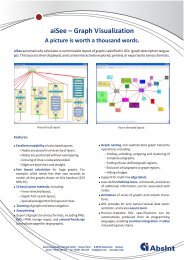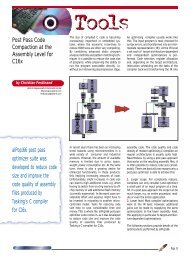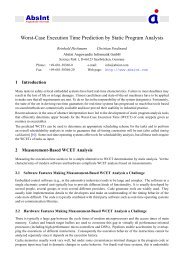5 Graph Description Language (GDL) - Absint
5 Graph Description Language (GDL) - Absint
5 Graph Description Language (GDL) - Absint
You also want an ePaper? Increase the reach of your titles
YUMPU automatically turns print PDFs into web optimized ePapers that Google loves.
6.4 Hierarchical Layout<br />
6.4.1 Rank Assignment<br />
After folding, all the visible nodes are determined. If all the visible nodes have been specified by<br />
the user using valid coordinates, the graph is drawn immediately. However, if the coordinates of<br />
at least one node are missing, an appropriate layout has to be calculated. The first pass places the<br />
nodes in discrete ranks. All nodes of the same rank appear at the same vertical position.<br />
There are many possibilities for assigning rank. The normal method is to calculate a spanning<br />
tree by determining the strongly connected components of the graph. All edges should be oriented<br />
top-down. A heuristic tries to find a minimum set of edges that cannot be oriented top-down.<br />
A faster method is to calculate the spanning tree of a graph by depth first search (DFS). However,<br />
the order in which the nodes are visited has a substantial influence on the layout. The initial order<br />
of the nodes is the order given by the graph specification. aiSee offers various versions of such<br />
methods:<br />
• dfs:<br />
Calculates the spanning tree by one single DFS traversal. This is the fastest method, but the<br />
quality of the result might be poor for some graphs.<br />
• maxdepth:<br />
Calculates the spanning tree by DFS using the initial order and the reverted initial order,<br />
followed by choosing the deepest spanning tree. This results in more levels, i.e. the graph is<br />
larger in the y direction.<br />
• mindepth:<br />
Takes the flatter spanning tree of both DFS’s. This results in fewer levels, or more nodes at<br />
the same levels, meaning the graph is larger in the x direction.<br />
• maxdepthslow, mindepthslow:<br />
Whereas the above algorithms are fast heuristics for increasing or decreasing the depth of<br />
the layout, maxdepthslow and mindepthslow actually calculate a good order so as to obtain<br />
a maximum or minimum spanning tree. However, they pose one disadvantage: they are<br />
rather slow. Warning: A minimum spanning tree does not necessarily mean that the depth<br />
of the layout is minimal. However, good heuristics involves obtaining a flat layout (see the<br />
examples on p. 53).<br />
• maxdegree, mindegree, maxindegree, minindegree<br />
maxoutdegree, minoutdegree:<br />
These algorithms combine DFS with node sorting. The sorting criteria are the number of<br />
incoming edges, the number of outgoing edges, and the number of edges all at the same<br />
node. Node sorting may have various effects and can sometimes be used as a fast alternative<br />
to maxdepthslow or mindepthslow.<br />
• minbackward:<br />
Instead of calculating strongly connected components, aiSee can also perform topological<br />
117





